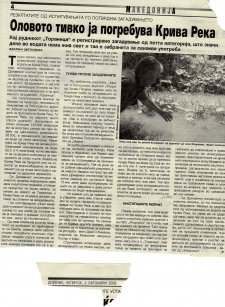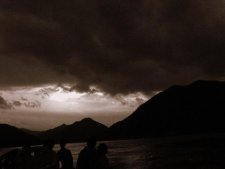By Lalanath de Silva (Posted: March 9, 2009)
The story of the Mae Moh coal plant in Thailand shows why early community engagement is critical to the development and implementation of a sustainable project.
On March 4, 2009, a landmark court decision provided much-needed relief for communities harmed by pollution from a controversial coal power project in northern Thailand. The story of Mae Moh highlights the importance of public participation and access to information in protecting the rights of communities affected by development projects.
About the Mae Moh Coal Power Project
The Mae Moh coal-fired power plant sits in the hills of Lampang in northern Thailand. The plant is an enormous complex consisting of 13 power generating stations. Until 2008, the project was the largest of its kind in Southeast Asia.
Near the power plant lies its fuel source—a lignite coal mine, where open-air pits cut a 135 square kilometer slice out of the surrounding farmland. The government predicts there is enough coal in the area to meet a large percentage of Thailand’s energy needs through 2035 (it currently provides 12% of Thailand’s electricity), and recently approved plans to expand the mine to access 187 million tonnes of additional, proven coal reserves.
Impacts on Local Communities
Sixteen communities live near the power plant and mine. As the project has expanded over time, the mine has grown closer to their lands (only 800 meters away from one village). The power plant has expanded from one unit of 75 Megawatts in 1978 to 13 units of 2,625 Megawatts in 1996, and now consumes over 40,000 tonnes of lignite each day.
Fifteen years ago, the size of the project reached a tipping point. Thousands of communities began to complain of respiratory illnesses and severe damage to their crops. The communities alleged that wind blew coal mine dust into their homes and farmlands and that the smokestacks of the power plant did not contain appropriate filters, allowing the release of sulfur dioxide, mercury, and other toxic chemicals into the air.
In 1992, the plant activated all 11 of its generating units (now expanded to 13), and within a few days thousands of people in the area began noticing breathing difficulties, nausea, and inflammation of their eyes and throats. Communities estimated that within 2 months, 50% of rice fields were damaged by sulfur dioxide emissions. In 1998, mobile inspection clinics organized by the government diagnosed 8,214 patients, and found that an estimated 3,463 suffered from respiratory illnesses. Communities alleged that the project was connected to several deaths, including six Mae Moh villagers who died from blood poisoning.
Communities also complained that chemicals from the plant leaked downhill into water supplies, where uninformed people fished from the water. In October 2003, the State Natural Resources and Environmental Policy and Planning Office found high levels of arsenic, chromium, and manganese in most water sources near the plant.
The Government’s Response
The communities claimed that the government continued to grant permits and licenses to expand the project despite these impacts, and that the government failed to inform stakeholders about the project’s environmental and health risks. As people experienced harm to their health and crops, they complained to the government, but felt the government was not responsive. Communities described how public relations officials made promises to address their concerns, but then failed to follow through.
Communities also complained to financiers of the project, including the Asian Development Bank, Export Development Canada, and the U.S. Export-Import Bank. In 2001, ADB financed an evaluation of the project’s environmental and health impacts, which brought sulfur dioxide emission levels into compliance with national standards. As a result, fewer people now suffer from respiratory illnesses.
While this was an important first step, the government’s and financiers’ responses did not address communities’ other concerns such as compensation for crop damages, resettlement to safer areas, and payment for medical treatment. As a result, the communities resorted to lawsuits for redress. In 2002, local activist Maliwan Najwirot created the Occupational Patients Rights Network, which has filed several lawsuits against the government. In May 2004, a court ruling awarded approximately US$142,500 to villagers for crop damages caused by the power plant.
On March 4, 2009, a Thai court ordered the government (the Electricity Generating Authority of Thailand) to pay $6,800 plus interest to each plaintiff in a lawsuit brought 5 years ago by several hundred villagers whose health was harmed from living near the project. The court also ordered the government to move affected people to new land at least five kilometers from the project, to rehabilitate the environment at the coal mine, and to replace a controversial golf course with trees. This landmark decision provides a much-needed turning point, so that Mae Moh communities can finally begin to restore and rebuild their lives.
Lessons Learned
During the struggles of the past decade, Mae Moh communities have turned their experiences into an important lesson for others. Representatives of other Thai communities frequently visit Ms. Najwirot and the site to learn how to organize themselves, and how to address the tensions that development projects can create between those community members who benefit from jobs and electricity, and those who are harmed.
Mae Moh also provides important lessons for governments and companies about the importance of engaging communities early and throughout the life of a project so they can better identify and mitigate risks, and build trust to resolve problems that do emerge. This in turn helps to prevent costs from disaster cleanup, lawsuits, and tarnished reputations.
Finally, the project demonstrates the importance of transparency and public participation in the review and approval of permits and licenses that entail potentially harmful activities. In Mae Moh’s case, engagement with communities could have provided an earlier indication that construction or expansion of the project was not worth the environmental and health risks.
For more information see the story on the World Resources Institute website.


